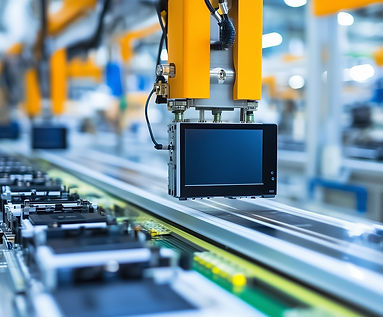
FACTORY AUTOMATION
Let AI Refine Your Production Lines With Efficiency

Powering Precision, Optimizing Production
We offer cutting-edge factory automation solutions that elevate industrial operations to new heights. Our comprehensive range of services, from system design and integration to maintenance and support, empowers businesses to achieve unparalleled efficiency, productivity, and quality. By harnessing the latest technologies, we deliver tailored solutions that streamline processes, reduce costs, and enhance overall competitiveness.

Robotics and Automation
Industrial robots and collaborative robots (cobots) represent distinct approaches to automation within manufacturing and industrial settings. Industrial robots are typically large, powerful machines designed for high-speed, repetitive tasks like welding, assembly, and heavy material handling, often operating within enclosed safety zones due to their potential hazards. Conversely, cobots are engineered to work safely alongside human workers, equipped with sensors and force-limiting capabilities that allow for close-proximity interaction. This collaborative nature enables cobots to enhance human capabilities, performing tasks that require precision, consistency, or ergonomic assistance, thereby increasing flexibility and safety within shared workspaces.
Our offerings include:
-
Industrial Robots: Deploying robotic arms for tasks like welding, assembly, and material handling.
-
Collaborative Robots (Cobots): Integrating robots that work alongside human workers for increased flexibility and safety.

Machine Vision

Machine vision, a critical component of modern automation, empowers systems to "see" and interpret visual information, dramatically enhancing efficiency across various industries. In the realm of image processing, machine vision analyzes visual data to perform intricate tasks like meticulous product inspection, precise defect identification, and the accurate guidance of robotic operations. This capability significantly elevates quality control and streamlines manufacturing processes. Furthermore, machine vision's ability to rapidly and reliably read barcodes and QR codes automates product tracking and inventory management, providing real-time data that optimizes supply chains and minimizes errors. This combination of image analysis and code recognition positions machine vision as a vital technology for increasing productivity and accuracy in increasingly automated environments.
Services include:
-
Image Processing: Analysing visual data to inspect products, identify defects, and guide robotic operations.
-
Barcode and QR Code Reading: Automating product tracking and inventory management.
.jpg)

Process Automation
In the realm of industrial automation, distinct systems play crucial roles in optimizing processes. Programmable Logic Controllers (PLCs) specialise in automating discrete manufacturing, executing sequential control to manage individual machines and production lines with rapid, real-time responses. Distributed Control Systems (DCS) are engineered for complex, continuous processes, such as those in chemical plants or oil refineries, where they utilise a distributed architecture to maintain precise control over interconnected variables. Finally, Supervisory Control and Data Acquisition (SCADA) systems provide a broad, supervisory layer, enabling the remote monitoring and control of large-scale industrial operations, gathering data from diverse field devices to facilitate centralised oversight and informed decision-making. These three systems often work in conjunction, creating a layered approach to industrial automation.
We offer:
-
Programmable Logic Controllers (PLCs): Automating discrete manufacturing processes through sequential control.
-
Distributed Control Systems (DCS): Controlling continuous processes like chemical reactions or oil refining.
-
Supervisory Control and Data Acquisition (SCADA): Monitoring and controlling large-scale industrial processes.

Motion Control
Motion control in factory automation relies heavily on the synergistic operation of servo drives, motion controllers, and SCADA systems. Servo drives provide the precise control necessary for individual motors and actuators, enabling accurate positioning and speed critical for tasks like robotic manipulation and material handling. Motion controllers then coordinate the movements of multiple axes, allowing for the execution of complex, synchronized tasks such as robotic assembly and intricate machining. Finally, SCADA systems provide the overarching monitoring and control of these systems across a large-scale industrial environment, allowing for real-time data acquisition, process visualization, and centralised management of the entire automated production line.
For motion control solutions, we have:
-
Servo Drives: Precisely controlling the motion of motors and actuators for accurate positioning and speed.
-
Motion Controllers: Coordinating multiple motion axes for complex tasks like robotic assembly.


Industrial IOT (IIoT)
Factory automation, driven by the Industrial Internet of Things (IIoT), is fundamentally transforming manufacturing landscapes. Within this evolution, operator panels play a crucial role, serving as intuitive human-machine interfaces (HMIs) that empower personnel to closely monitor and precisely control complex automation systems. Complementing this, remote monitoring capabilities, facilitated by IIoT connectivity, allow for access and troubleshooting of equipment from virtually any location. This remote access not only minimizes downtime by enabling swift responses to issues but also optimizes operational efficiency by providing real-time data and control, regardless of physical location.
Key IIoT services are:
-
Data Acquisition: Collecting real-time data from sensors and machines.
-
Data Analytics: Analyzing data to identify trends, optimize processes, and predict maintenance needs.
-
Predictive Maintenance: Using data to proactively schedule maintenance and prevent equipment failures.


Human-Machine Interface
In factory automation, the Human-Machine Interface (HMI) plays a pivotal role in bridging the gap between human operators and complex automated systems. By providing intuitive graphical interfaces, HMIs enable real-time monitoring and precise control of machinery, streamlining operations and minimizing errors. Complementing this, remote monitoring capabilities extend operational oversight beyond the factory floor, allowing for off-site access, diagnostics, and troubleshooting. This remote functionality enhances responsiveness, reduces downtime, and facilitates proactive maintenance, ensuring continuous and efficient production processes. Together, these HMI and remote monitoring functions are essential components of modern factory automation.
Our HMI services include:
-
Operator Panels: Providing intuitive interfaces for monitoring and controlling automation systems.
-
Remote Monitoring: Enabling remote access and troubleshooting of equipment.



